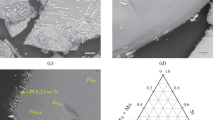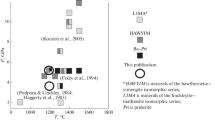Summary
Corona structures occur in the upper units (UGAZ and UA) of the Niquelândia mafic-ultramafic complex (Central Goiás, Brazil), where olivine gabbros, gabbros, anorthosites and “amphibolites” are interlayered. In olivine gabbros, where the corona structures are most complex, primary igneous minerals are olivine, plagioclase ± clinopyroxene and ilmenite. The instability between olivine and plagioclase results in three types of coronas:
-
1)
ol + pl → opx + (cpx + sp)sympl
-
2)
ol + pl → opx + (amph + sp)sympl
-
3)
ol + pl → opx + amph + gar
In the second corona type the amphibole is pargasite; in the third type the amphibole approaches Mg-hornblende in composition. The occurrence of secondary amphibole indicates the presence of a fluid phase during re-equilibration.
Reaction calculations, obtained by means of a “MIXING” program, show that the mineralogical changes in the three corona types may reasonably have occurred in a closed system (with the exception of the fluid phase).
The chemical composition of the reacting igneous phases (especially the Mg/Fe2+ ratio of the mafic phases) constrains the composition of the products, but not the type of secondary assemblage. The nature of these products depends mainly on the variations ofaH2O, in relation to temperature decrease. In gabbros, anorthosites and “amphibolites”, where orthopyroxene and/or amphibole may be intercumulus phases, the following reactions occur between pyroxenes and plagioclase:
-
4)
opx + cpx + pl → hbl
-
5)
opx + cpx + pl → hbl + gar ± qz
-
6)
opx + pl → cpx + gar + qz
In these rocks, garnet formation as a product in reaction (5) depends on the partial pressure of a vapour phase. Reaction (6) develops only when the orthopyroxene is very iron-rich.
Estimates of the re-equilibration pressure are of 5–8 kb; re-equilibration temperatures vary from about 800°C (anhydrous corona in olivine gabbros) to 560°C (plag + hbl + gar + qz secondary assemblages). Temperatures obtained from the hbl - gar geothermometer are directly correlated with the pargasitic component in secondary amphiboles.
The absence of deformation suggests that the coronas formed during slow cooling and not during a metamorphic event. The present data do not provide an answer to the problem of whether H2O has been introduced from the country rocks or is of igneous origin.
Zusammenfassung
Coronastrukturen kommen in den oberen Einheiten (UGAZ und UA) des mafisch-ultramafischen Komplexes von Niqueländia (Central Goiâs, Brasilien) dort vor, wo Olivin-Gabbros, Gabbros, Anorthosite und “Amphiboliten” in Wechsellagerung auftreten.
In den Olivin-Gabbros sind die Coronastrukturen besonders komplex. Die primären magmatischen Minerale sind hier Olivin, Plagioklas ± Klinopyroxen und Ilmenit. Die Instabilität zwischen Olivin und Plagioklas produziert drei verschiedene Arten von Coronen:
-
1)
Ol + Pl → Opx + (Cpx + Sp)Sympl
-
2)
Ol + Pl → Opx + (Amph + Sp)Sympl
-
3)
Ol + Pl → Opx + Amph + Gr
Im Coronatyp (2) ist der Amphibol ein Pargasit, während seine Zusammensetzung im Typ (3) eher einer Mg-Hornblende entspricht. Das Vorkommen von sekundärem Amphibol deutet darauf hin, daß bei der Reequilibrierung eine fluid Phase mitgewirkt hat. Die mittels eines “MIXING”-Programmes erhaltenen Reaktionen sind mit der Vorstellung verträglich, daß sich die mineralogischen Umwandlungen in den drei Coronatypen in einem geschlossenen System abliefen (abgesehen von der fluiden Phase).
Die chemische Zusammensetzung der reagierenden Primärphasen (insbesondere das Mg/Fe2+-Verhältnis der mafischen Phasen) schränkt die Möglichkeiten für die Zusammensetzung der Reaktionsprodukte ein, bestimmt aber nicht ihren Typ. Der Typ ist in erster Linie durch Variationen vonaH2O in Relation zur Abkühlung bestimmt.
In Gabbros, Anorthositen und “Amphiboliten”, in denen es sich bei Orthopyroxen und/oder Amphibol möglicherweise um Interkumulus Phasen handelt, gibt es zwischen Pyroxen und Plagioklas die folgenden Reaktionen:
-
4)
Opx + Cpx + Pl → Hbl
-
5)
Opx + Cpx + Hbl + Gr ± Qz
-
6)
Opx + Pl → Cpx + Gr + Qz
In der Reaktion (5) ist die Granatbildung durch den Partialdruck der Dampfphase bestimmt. Die Reaktion (6) spielt nur bei sehr eisenreichen Orthopyroxenen eine Rolle.
Eine Abschätzung des Reequilibrierungsdrucks ergibt 5–8 kb; Reequilibrierungs-temperaturen variieren zwischen 800°C (für wasserfreie Coronen in Olivingabbros) und 560°C (für sekundäre Paragenesen aus PI + Hbl + Gr + Qz). Die aus der Hbl - Gr Geothermometrie abgeleiteten Temperaturen sind mit der Pargasitkomponente im sekundären Amphibol korreliert.
Das Fehlen von Deformationsstrukturen zeigt, daß sich die Coronen während langsamer Abkühlung, nicht aber im Verlauf eines Metamorphose-Ereignisses ausgebildet haben. Die vorliegenden Daten liefern keine Antwort auf die Frage, ob das H2O aus den Nebengesteinen stammt oder magmatischen Ursprungs ist.
Similar content being viewed by others
References
Albee AL, Ray L (1970) Correction factors for electron microanalysis of silicates, oxides, carbonates, phosphates and sulphates. Anal Chem 42: 1408–1414
Bence AE, Albee AL (1968) Empirical correction factors for the electron microanalysis of silicates and oxides. J Geol 76: 382–403
Candia Fornoni MA (1983) Petrologia dos complexos mafico-ultramaficos de Mangabal I e Mangabal 11, Sanclerlândia, Goiás. Unpub. Ph.D. thesis, Instituto de Geociências Universidade de São Paulo (Brazil)
Danni JCM, Fuck RA, Leonardos OH (1982) Archean and lower Proterozoic units in central Brazil. Geol Rundschau 71 (1): 291–317
Davis JC (1986) Statistics and data analysis in geology, (second edition). John Wiley & Sons, New York Chichester Brisbane Toronto Singapore, 646 pp.
Ellis DJ, Green DH (1979) An experimental study of the effect of Ca upon garnet-clinopyroxene Fe-Mg exchange equilibria. Contr Min Petrol 71: 13–22
Esbensen KH (1978) Coronites from the Fongen gabbro complex, Trondheim Region, Norway: role of water in the olivine-plagioclase reaction. N Jb Min Abh 132: 113–135
Ganguly J (1979) Garnet and clinopyroxene solid solutions and geothermometry based on Fe-Mg distribution coefficient. Geochim Cosmochim Acta 43: 1021–1029
Gardner PM, Robins B (1974) The olivine-plagioclase reaction: geological evidence from the Seiland petrographic province. Northern Norway. Contr Min Petrol 44: 149–156
Girardi VAV, Rivalenti G, Sinigoi S (1986) The petrogenesis of the Niquelândia complex, Central Goiâs, Brazil. J Petrol 27 (3): 715–744
Glassley WE, Sorensen K (1980) Transition in Agto (West Greenland) metadolerites: implications and applications. J Petrol 21: 69–105
Graham CM, Powell R (1984) A garnet-hornblende geothermometer: calibration, testing and application to the Pelona Schist, Southern California. J metam Geol 2: 13–31
Green DH, Ringwood AE (1967) An experimental investigation of the gabbro to eclogite transformation and its petrological applications. Geochim Cosmochim Acta 31: 767–833
Griffin WL (1971) Genesis of coronas in anorthosites of the upper Jotun Nappe, Indre Sogn, Norway. J Petrol 12 (2): 219–243
——Heier KS (1969) Parageneses of garnet in granulite-facies rocks, Lofoten-Vesteraalen, Norway. Contr Min Petrol 23: 89–116
—— —— (1973) Petrological implications of some corona structures. Lithos 6: 315–335
——Mellini M, Oberti R, Rossi G (1985) Evolution of coronas in Norwegian anorthosites: re-evaluation based on crystal-chemistry and microstructures. Contr Min Petrol 91: 330–339
Harley SL, Green DH (1982) Garnet-orthopyroxene barometry for granulites and peridotites, Nature 300: 697–701
Johnson CA, Essence EJ (1982) The formation of garnet in olivine-bearing metagabbros from the Adirondacks. Contr Min Petrol 81: 240–251
Kushiro I, Yoder Jr HS (1966) Anorthite-forsterite and anorthite-enstatite reactions and their bearing on the basalt-eclogite transformation. J Petrol 7: 337–362
Lamoen H Van (1979) Coronas in olivine gabbros and iron ores from Susimäki and Riuttamaa, Finland. Contr Min Petrol 68: 259–268
Leake BE (1978) Nomenclature of Amphiboles. Am Mineralogist 63: 1023–1052.
Mazzucchelli M (1983) The upper zone of the Ivrea-Verbano layered complex (Italian Western Alps). N Jb Miner Abh 141 (1): 101–116
McLelland JM, Whitney PR (1980a) A generalized garnet-forming reaction for metaigneous rocks in the Adirondacks. Contr Min Petrol 72: 111–122
—— (1980b) Compositional controls on spinel clouding and garnet formation in plagioclase of olivine metagabbros, Adirondacks Mountains, New York. Contr Min Petrol 73: 243–251
Miller C (1974) Reaction rims between olivine and plagioclase in metaperidotites, Ötztal Alps, Austria. Contr Min Petrol 43: 333–342
Mongkoltip P, Ashworth JR (1983) Quantitative estimation of an open-system symplectiteforming reaction: restricted diffusion of Al and Si in coronas around olivine. J Petrol 24: 635–661
Newton RC, Perkins III D (1982) Thermodynamic calibration of geobarometers based on the assemblages garnet-plagioclase-orthopyroxene (clinopyroxene)-quartz. Am Mineralogist 67: 203–222
Nishiyama T (1983) Steady diffusion model for olivine-plagioclase corona growth. Geochim Cosmochim Acta 47: 283–294
Rivalenti G, Girardi VAV, Sinigoi S, Rossi A, Siena F (1982) The Niquelândia maficultramafic complex of Central Goiâs, Brazil: petrological consideration. Revista Brasileira de Geociências 12: 380–391
Sapountzis ES (1975) Coronas from the Thessalonike gabbros (North Greece). Contr Min Petrol 51: 197–203
Thompson Jr JB, Laird J, Thompson AB (1982) Reactions in amphibolite, greenschist and blueschist. J Petrol 23 (1): 1–27
Wells PRA (1977) Pyroxene thermometry in simple and complex system. Contr Min Petrol 62: 129–139
Whitney PR (1972) Spinel inclusions in plagioclase of metagabbros from Adirondack Highlands. Am Mineralogist 57: 1429–1439
——McLelland JM (1973) Origin of coronas in metagabbros of the Adirondack Mts., N.Y. Contr Min Petrol 39: 81–98
Wood BJ (1974) The solubility of alumina in orthopyroxene coexisting with garnet. Contr Min Petrol 46: 1–15
——Banno S (1973) Garnet-orthopyroxene and orthopyroxene-clinopyroxene relationship in simple and complex systems. Contr Min Petrol 42: 109–124
Author information
Authors and Affiliations
Rights and permissions
About this article
Cite this article
Fornoni Candia, M.A., Mazzucchelli, M. & Siena, F. Sub-solidus reactions and corona structures in the Niquelândia layered complex (Central Goiás, Brazil). Mineralogy and Petrology 40, 17–37 (1989). https://doi.org/10.1007/BF01162467
Received:
Accepted:
Issue Date:
DOI: https://doi.org/10.1007/BF01162467




